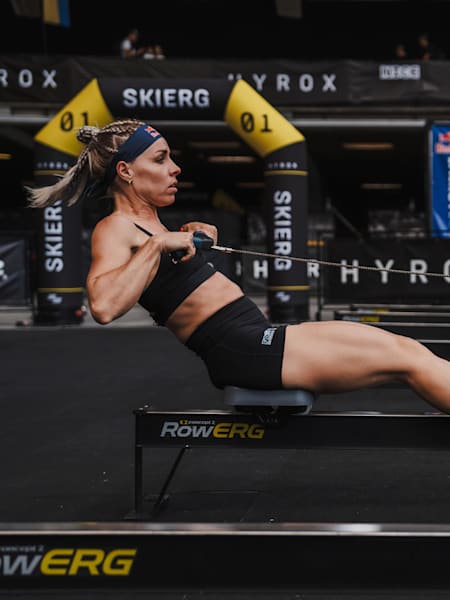Whether you’re training for a HYROX competition or simply want to take your fitness to the next level, hybrid training can help push you and create a well-rounded, functional set of abilities.
"Hybrid training gives me a sense of satisfaction, because you’re strong and relatively fit at the same time,” says Jake Dearden, HYROX champion and master trainer. "A lot of times, we focus on one over the other, but it's not much good being super strong if you don't also have the fitness to walk up a flight of stairs without getting out of breath."
What is HYROX?
Not familiar with HYROX? The premise is simple. In a race format you will run a kilometre, complete a functional workout challenge and run again. Eight kilometres, eight challenges.
The brainchild of Christian Toetzke, a veteran of cycling, marathon and triathlon events, alongside three-time Olympic medallist Moritz Fuerste and marketer guru Michael Trautmann, HYROX began in Germany in 2017. It's sky-rocketed since then, with 40 races in 2023 alone seeing 90,000 participants and 50,000 spectators get involved from London to Sydney and Taipei.
For Dearden, a huge benefit of hybrid training for events like HYROX is that it isn't based on aesthetics; because you're comparing your performance against past races, you actually have the metrics that tell you how fit you're becoming.
Here's what you need to know.
What is hybrid training?
Hybrid training simply means training in more than one modality.
For example, some of us might cycle, some of us might run and some might focus on lifting weights. Hybrid training, like that required for HYROX, asks you to challenge your body by pushing it through its full range of functional movements while also throwing in a healthy dose of cardio in the running sections.
Shorter than a half marathon, the cardio training will definitely help ramp up your metabolism, while the resistance training – that's the weighted stuff – is designed to boost balance, strength and endurance all at the same time.
This means that almost every muscle will get a complete workout and your lungs will be burning by the end, too.
But don’t worry, you don’t need to be the best athlete in the world to enter a race. You can move at your own-pace alongside competitors of your own ability level.
Will hybrid training build muscle?
The thinking goes that cardio kills gains: move too much instead of solely focusing on weights and your body will use your new muscle mass for fuel, preventing you from getting absolutely swole.
While there's some truth to this, a look at any HYROX competitor shows that you can certainly get absolutely built while combining resistance training and cardio.
But what does the science say? It turns out that hybrid training not only benefits your performance, but also your overall fitness and cardiovascular health, while reducing your risk of injury at the same time.
First of all, a study published in AHA Journals in June 2022 looked at the impact different training types had on cardio fitness by systematically reviewing 81 randomised controlled trials. The study ended up looking at data from 4331 individuals, 59 percent of whom were female.
It found that, "Combined training was the most effective modality and hybrid-type training the second most effective in improving cardiometabolic health-related outcomes in these populations,." This means that hybrid training ranked better than HIIT, steady state jogging and pure weight training for safeguarding your heart and lungs.
Another study, in the British Journal of Sports Medicine, asked whether pro athletes could train smarter and harder to avoid injury. The paper explored the 'Training-Injury Prevention Paradox' model, concurring that slowly ramping up your training over time while mixing-up your workout protocols (as per hybrid training), leads to better fitness overall, greater strength and a decrease in your chance of getting injured.
Still not convinced? A final study in the Kurume Medical Journal focused on arms, with three different control groups training three times a week for six weeks. Metrics including: grip strengths, forearm flexor/extensor cross sectional areas, hand dexterity and finger tapping were measured, with researchers concluding that hybrid training "increases muscle strength and mass in the forearm without adverse effect of hand function in healthy male subjects."
“You can definitely build muscle while following hybrid training protocols,” adds Dearden. With one caveat: you need to make sure that you're in a slight calorie surplus.
"Anything high intensity and lasting longer than 60 minutes, you need to be fuelling mid-session, because our oxygen stores only last 90 minutes and once they run out your body will look elsewhere for energy. And it can break down muscle muscle faster than fat," Dearden explains. "As long as we still have carbohydrates in our system and our sessions don't go on for too long, then we can obviously build strength."
What's an example of a hybrid training program?
As mentioned above, HYROX is so popular due to the fact that it repeats exercises, alternating 1km runs with eight functional movement stations.
Let's get specific. The first station is a 1km sprint on the ski-erg, a full-body cardio machine you've likely grappled with in your local gym. Next is a 50m weighted sled push, then a 50m sled pull, 80m burpee broad jump, a 1km row, 200m farmer's carry, 100m lunge and, finally, 75 or 100 reps of wall balls.
Naturally, you'll want to practice these core movements and, as it makes up half of the event, running should make up a good percentage of your training.
"You should absolutely get confident with the HYROX movements first," says Dearden. "That's just going to improve your efficiency."
In terms of accessory work to strengthen the muscles needed for HYROX, without having to only focus on the HYROX workouts, Dearden says squats, deadlifts and single-leg lunges are great options.
"Focus on doing a lot of compound movements – a lot of swaps, a lot of deadlifts," he suggests. As mentioned above, HYROX is so popular due to the fact that it repeats exercises.
Experts recommend giving yourself at least 12 weeks to get in shape for your first event, with your training split more or less evenly between medium intensity cardio, like a decent 10km run; more intensive cardio like a treadmill sprint session, or a blast on the ski erg; and strength training, focusing on compound moves like bench presses, deadlifts and squats that will build muscle across your entire body.
For beginners, Dearden suggests keeping it simple, either splitting sessions into half strength, half conditioning with 20 to 30 minutes conditioning at the end of each session, or by separating the different modalities into different days.
What not to do
What you don't want to do is combine your existing strength programme with a separate running programme. As Dearden explains, do this and you’ll just be doing two different workouts side-by-side – workouts that aren’t necessarily complimentary in the true spirit of hybrid training. It’s much better to blend them together, tweaking separate sessions to compliment your overall goals.
"I do two days of strength work, two days running work, kind of focusing on speed and speed endurance. Then, I do one big conditioning session, building up that ability to move on fatigued legs. Just try to keep getting stronger."
Ultimately, the key to success, as Dearden knows, is to focus on your weaknesses. Don’t like running? Well it’s time to up your game. Not a fan of burpees? No one is, but get stuck in anyway. And. most importantly of all, don't forget to have fun.














